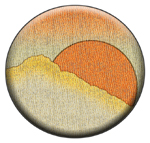On The Way: The Daily Zen Journal
The Eight Qualities of a Great Person Part 2
Dogen (1200-1253)

5. Not Losing Sight of True Dharma – Fumonen
The fifth quality is also called observing the true teaching. This is also called keeping true dharma. Maintaining and not losing sight of true dharma is called practicing the true teaching. This is also called not losing sight of the teaching.
The Buddha said, “Monks, in searching for a true teacher and good protector, there is nothing better than always being mindful of the dharma. Those who stay aware and are not careless or forgetful in their actions will not be torn apart by the various thieves of greed, ignorance, or anger.
“For that reason, Monks, you should take in and be ever mindful of the teaching. Those who lose sight of staying aware will lose all merit and benefit as well. As a result of constantly remaining determined and mindful, though you may be among the thieves of the five senses, you will never suffer harm from them. It is like wearing armor and being in a strong encampment: there will be nothing to fear. This is called not losing sight of true dharma.”
6. Concentrating on Settling in Dhyana – Shuzenjo
The sixth realization is practicing dhyana-samadhi (zazen). Abiding in buddhadharma and remaining undisturbed is called settling in dhyana.
The Buddha said, “Monks, those who wish to settle the confusions of the mind need to sit quietly in dhyana. Having contemplated thoroughly the functioning of one’s mind, you will come to know well the rise and fall of all worldly phenomena. For that reason, you must make diligent effort to concentrate on and carry out various forms of settling in dhyana.
“Concentrating on dhyana, the mind will no longer be lost in confusion. It is like a house that has little water; the owner will build a dam or barrier to prevent the water from escaping. Practitioners must do the same. For the sake of the water of wisdom, practice dhyana-samadhi so that nothing may leak out. This is called concentrating on settling in dhyana.”

7. Practicing Wisdom – Shuchi’e
The seventh quality is to embody the wisdom of liberation from one’s attachments-shuchi’e. Realization based on hearing the teaching of buddhadharma and contemplating and practicing it is wisdom.
The Buddha said, “Monks, if you have wisdom, you will never become greedy. You must constantly reflect on yourself and never allow the loss of wisdom. That is how you will be liberated through dharma. One who does not act like that cannot be said to be a person of the Way. Nor can such a person be called a lay follower either. There is no name for one who does not carry out wisdom.
“True wisdom, like a strong and durable boat, will ferry you and others across the sea of sickness, old age, and death. It is like a brilliant lamp that lights up ignorance and darkness. It is medicinal for all who are sick and infirm. It is like cutting down the tree of ignorance, hatred, and cravings with a sharp ax.
“For this reason, it is important to increase even more the wisdom derived from hearing the dharma, contemplating deeply and carrying out true actions. If there is one who embodies wisdom, though he or she is only human and sees with a human eye, that person is one who can see. This is called wisdom.”

8. Not Engaging in Useless Argument – Fukeron
The eighth quality is not involving oneself in spurious talk or useless argument that is not beneficial. To realize Buddha’s teaching and not get caught up in illusory discrimination is not engaging in useless arguments. To pursue the true reality of dharma is nothing other than not getting involved in useless discussion.
The Buddha said, “Monks, the mind that partakes in useless or frivolous discussion will only become confused and scattered. Even though you may have decided to leave home, you will never be emancipated.
“Monks, throw away and distance yourself from all such useless and confusing discussions. If you wish to enjoy the peace and serenity of nirvana, all you need to do is wipe out the sickness of idle talk or useless discussion. This is what is called not engaging in useless argument.”
These are the eight qualities of a great person. This final teaching and guidance of our great teacher Shakyamuni is, moreover, the teaching of the Mahayana. This was the ultimate and final teaching given on the evening of the fifteenth day of February. Shakyamuni gave no further sermons and entered parinirvana.
The Buddha said, “Monks, endeavor with all your heart to leave the six realms of delusion. All things that are alive, moving or not moving—all things that fall apart and come to nothing –cause one to feel insecure and ill at ease. All of you, for a while just keep still and refrain from all speech.
“Now my final moment is at hand. I am about to enter a nirvana that has destroyed all worldly cravings and delusions. These are my final words.”
For this reason, the disciples of the Tathagata all studied and practiced these eight qualities. Therefore, anyone who does not know and practice these qualities is not a disciple of the Buddha. This is the Tathagata’s wisdom of the realization of having destroyed all cravings and delusions. Despite that, many today know nothing of these qualities.

The reason so few have neither seen them acted out nor heard them talked about is that their hearts and minds have been preyed upon by distractions.
Few have laid deep roots in carrying out good, because they have neither heard about these qualities nor seen them in action. In the past, during the time when the correct dharma was practiced or later when it was at least heard, those disciples of the Buddha learned and manifested these qualities through their practice. But today, only one or two out of a thousand monks know of these eight qualities.

It is truly a pity. There is no example of such deterioration of the buddhadharma as in our current degenerate age. The Buddha’s true dharma has spread throughout the world. You must learn and practice his true teaching before it disappears. To encounter buddhadharma at any time, even over infinite kalpas of time, is rare.
There are those who died before the Buddha entered nirvana. Unfortunately, they were never able to hear about these eight qualities or learn or practice them. Today, we have had the good fortune to be able to hear this teaching and practice it, thanks to the roots of goodness planted earlier.
Therefore, it is critical for us to study and practice these qualities, to expand their merit throughout time, to realize deepest wisdom, and, finally, just as the Buddha did, to realize deepest wisdom for the benefit of all beings.
Dogen (1200-1253)
Excerpted from The Roots of Goodness – Eihei Dogen with commentary by Kosho Uchiyama and translated by Tom Wright
 As with any translation of a very ancient teaching, and one that was passed on orally rather than written down, we are often stopped wondering what was actually transmitted. The first four qualities seem straightforward enough and relatively easy to focus on as a practice point.
As with any translation of a very ancient teaching, and one that was passed on orally rather than written down, we are often stopped wondering what was actually transmitted. The first four qualities seem straightforward enough and relatively easy to focus on as a practice point.
The second point, knowing one has enough, comes up continually in our daily lives. We all can understand making diligent effort in continuing past obstacles that arise in many different ways.
But when we get to the fifth realization, observing the true Dharma, here some of us might stop and wonder, “What would I call keeping the true Dharma?” Apart from the many teachings of Buddhism that are very well known to beginners and those who have practiced for many years, many will find an essential phrase or ideal that seems to represent the heart of the Dharma.
In reality, it will probably be something a bit different for each of us, depending on our tendencies. For anything to have a deep impact, it is very helpful to “translate” it ourselves into a phrase or word that grounds the Dharma into our lives.
For example, impermanence might be one view that comes to mind, easily witnessed in nature. The middle way, which expresses that balance point between extremes, becomes a useful way of action for some. And there are heart-centered ones like compassion, which we can lean on when events try to pull us into the drama of life.
Essentially, true dharma needs to be something we put into practice, something beyond dogma that can become mechanical recitation.
The seventh quality, practicing wisdom, is no easy task to experience, as attachment and aversion seem almost hardwired into us. This is a lifelong path as liberation from one’s attachments and sense of self is ongoing.
And, finally, the eighth quality seems self-evident even if it is difficult to remember at times.
Meditation is the bedrock of all these qualities. Meditation in action takes us one step further. If Dogen, back in the 1200’s, wrote that “there is no example of such deterioration of the buddhadharma as in our current degenerate age,” where does that put our own timeline? Once we learn of the Dharma, is it not our path to manifest it in our actions? Translating Dharma into daily life,
Translating Dharma into daily life,
Elana, Scribe for Daily Zen




